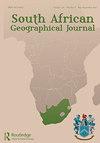The first national scale spatial and temporal analysis of surface CO2 over South Africa utilising satellite retrievals
IF 1.4
4区 社会学
Q3 GEOGRAPHY
引用次数: 0
Abstract
ABSTRACT South Africa is the dominant continental source region of CO2 fossil fuel emissions. This is a result of the strong dependence of its economy on fossil fuels. However, the observations of atmospheric CO2 in South Africa are inadequate. The country has the Global Atmospheric Watch (GAW) Cape Point station as the only site with long-term ambient CO2 monitoring record. In this study, satellite data retrieved from the Tropospheric Emission Spectrometer (TES) instrument on board the Aura satellite from Dec 2004 to Dec 2009 is used for the first time to quantify the spatial distribution of CO2 over South Africa, as well as to determine its annual variability at selected sites. The study found that the surface CO2 foot print in South Africa resembles the industrial CO2 emission sources spatial distribution, particularly during the summer and autumn. In winter and spring seasons the surface CO2 foot prints are spatially expanded as a result of contributions of emissions from biomass and domestic fossil fuel combustion. The surface levels of CO2 at the study areas have been increasing during the period of the analysis.首次利用卫星资料对南非地表二氧化碳进行全国尺度的时空分析
南非是化石燃料二氧化碳排放的主要大陆源区。这是中国经济严重依赖化石燃料的结果。然而,对南非大气二氧化碳的观测是不充分的。该国拥有全球大气监测(GAW)开普角站,这是该国唯一拥有长期环境二氧化碳监测记录的站点。本研究首次利用2004年12月至2009年12月从Aura卫星上搭载的对流层发射光谱仪(TES)获取的卫星数据,量化了南非上空二氧化碳的空间分布,并确定了其在选定地点的年变率。研究发现,南非地表CO2足迹与工业CO2排放源的空间分布相似,特别是在夏秋两季。在冬季和春季,由于生物质和家庭化石燃料燃烧排放的贡献,地表CO2足迹在空间上扩大。在分析期间,研究区域的表面二氧化碳水平一直在增加。
本文章由计算机程序翻译,如有差异,请以英文原文为准。
求助全文
约1分钟内获得全文
求助全文
来源期刊

South African Geographical Journal
GEOGRAPHY-
CiteScore
3.40
自引率
7.10%
发文量
25
期刊介绍:
The South African Geographical Journal was founded in 1917 and is the flagship journal of the Society of South African Geographers. The journal aims at using southern Africa as a region from, and through, which to communicate geographic knowledge and to engage with issues and themes relevant to the discipline. The journal is a forum for papers of a high academic quality and welcomes papers dealing with philosophical and methodological issues and topics of an international scope that are significant for the region and the African continent, including: Climate change Environmental studies Development Governance and policy Physical and urban Geography Human Geography Sustainability Tourism GIS and remote sensing
 求助内容:
求助内容: 应助结果提醒方式:
应助结果提醒方式:


